Domain Diversity and Polarization Switching in Amino Acid β-Glycine
Abstract
:1. Introduction
2. Materials and Methods
3. Results and Discussion
3.1. As-Grown Domain Structure
3.2. Local Polarization Reversal
4. Conclusions
Supplementary Materials
Author Contributions
Funding
Acknowledgments
Conflicts of Interest
References
- Lines, M.E.; Glass, A.M. Principles and Applications of Ferroelectrics and Related Materials, 1st ed.; Clarendon Press: Oxford, UK, 1977; pp. 559–604. [Google Scholar]
- Shur, V.Y. Lithium Niobate and Lithium Tantalate-based Piezoelectric Materials. In Advanced Piezoelectric Materials, 1st ed.; Uchino, K., Ed.; Woodhead Publishing: Cambridge, UK, 2010; pp. 204–238. [Google Scholar]
- Acosta, M.; Novak, N.; Rojas, V.; Patel, S.; Vaish, R.; Koruza, J.; Rossetti, G.A.; Rödel, J. BaTiO3-based piezoelectrics: Fundamentals, current status, and perspectives. Appl. Phys. Rev. 2017, 4, 041305. [Google Scholar] [CrossRef]
- Cardoso, V.F.; Correia, D.M.; Ribeiro, C.; Fernandes, M.M.; Lanceros-Méndez, S. Fluorinated polymers as smart materials for advanced biomedical applications. Polymers 2018, 10, 161. [Google Scholar] [CrossRef] [PubMed]
- Hutmacher, D.W. Scaffolds in tissue engineering bone and cartilage. Biomaterials 2000, 21, 2529–2543. [Google Scholar] [CrossRef]
- Chen, P.-J.; Saati, S.; Varma, R.; Humayun, M.S.; Tai, Y.-C. Wireless intraocular pressure sensing using microfabricated minimally invasive flexible-coiled LC sensor implant. J. Microelectromech. Syst. 2010, 19, 721–734. [Google Scholar] [CrossRef]
- Vallet-Regí, M.; Balas, F.; Arcos, D. Mesoporous materials for drug delivery. Angew. Chem. Int. Ed. 2007, 46, 7548–7558. [Google Scholar] [CrossRef]
- Chorsi, M.T.; Curry, E.J.; Chorsi, H.T.; Das, R.; Baroody, J.; Purohit, P.K.; Ilies, H.; Nguyen, T.D. Piezoelectric biomaterials for sensors and actuators. Adv. Mater. 2019, 31, 1802084. [Google Scholar] [CrossRef]
- Xu, W.-J.; Kopyl, S.; Kholkin, A.; Rocha, J. Hybrid organic-inorganic perovskites: Polar properties and applications. Coord. Chem. Rev. 2019, 387, 398–414. [Google Scholar] [CrossRef]
- Kholkin, A.L.; Amdursky, N.; Bdikin, I.; Gazit, E.; Rosenman, G. Strong piezoelectric activity in peptide nanotubes. ACS Nano 2010, 4, 610–614. [Google Scholar] [CrossRef]
- Lemanov, V.V. Piezoelectric and pyroelectric properties of protein amino acids as basic materials of Soft State Physics. Ferroelectrics 2000, 238, 211–218. [Google Scholar] [CrossRef]
- Guerin, S.; Stapleton, A.; Chovan, D.; Mouras, R.; Gleeson, M.; McKeown, C.; Noor, M.; Silien, C.; Rhen, F.; Kholkin, A.; et al. Control of piezoelectricity in amino acids by supramolecular packing. Nat. Mater. 2018, 17, 180–186. [Google Scholar] [CrossRef]
- Goryainov, S.V.; Boldyreva, E.V.; Kolesnik, E.N. Raman observation of a new (ζ) polymorph of glycine? Chem. Phys. Lett. 2006, 419, 496–500. [Google Scholar] [CrossRef]
- Boldyreva, E.V.; Drebushchak, V.A.; Drebushchak, T.N.; Paukov, I.E.; Kovalevskaya, Y.A.; Shutova, E.S. Polymorphism of glycine: Thermodynamic aspects. Part I. Relative stability of the polymorphs. J. Ther. Anal. Calorim. 2003, 73, 409–418. [Google Scholar] [CrossRef]
- Heredia, A.; Meunier, V.; Bdikin, I.K.; Gracio, J.; Balke, N.; Jesse, S.; Tselev, A.; Agarwal, P.; Sumpter, B.G.; Kalinin, S.V.; et al. Nanoscale ferroelectricity in crystalline γ-glycine. Adv. Funct. Mater. 2012, 22, 2996–3003. [Google Scholar] [CrossRef]
- Hu, P.; Hu, S.; Huang, Y.; Reimers, J.R.; Rappe, A.M.; Li, Y.; Stroppa, A.; Ren, W. Bioferroelectric properties of glycine crystals. J. Phys. Chem. Lett. 2019, 10, 1319–1324. [Google Scholar] [CrossRef]
- Marchesano, V.; Gennari, O.; Mecozzi, L.; Grilli, S.; Ferraro, P. Effects of lithium niobate polarization on cell adhesion and morphology. ACS Appl. Mater. Interfaces 2015, 7, 18113–18119. [Google Scholar] [CrossRef]
- Kubel, F.; Schmid, H. Structure of a ferroelectric and ferroelastic monodomain crystal of the perovskite BiFeO3. Acta Crystallogr. B 1990, 46, 698–702. [Google Scholar] [CrossRef]
- Seyedhosseini, E.; Ivanov, M.; Bystrov, V.; Bdikin, I.; Zelenovskiy, P.; Shur, V.Y.; Kudryavtsev, A.; Mishina, E.D.; Sigov, A.S.; Kholkin, A.L. Growth and nonlinear optical properties of β-glycine crystals grown on Pt substrates. Cryst. Growth Des. 2014, 14, 2831–2837. [Google Scholar] [CrossRef]
- Isakov, D.; Petukhova, D.; Vasilev, S.; Nuraeva, A.; Khazamov, T.; Seyedhosseini, E.; Zelenovskiy, P.; Shur, V.Y.; Kholkin, A.L. In situ observation of the humidity controlled polymorphic phase transformation in glycine microcrystals. Cryst. Growth Des. 2014, 14, 4138–4142. [Google Scholar] [CrossRef]
- Pertsev, N.A.; Kholkin, A.L. Subsurface nanodomains with in-plane polarization in uniaxial ferroelectrics via scanning force microscopy. Phys. Rev. B 2013, 88, 174109. [Google Scholar] [CrossRef]
- Alikin, D.O.; Ievlev, A.V.; Turygin, A.P.; Lobov, A.I.; Kalinin, S.V.; Shur, V.Y. Tip-induced domain growth on the non-polar cuts of lithium niobate single-crystals. Appl. Phys. Lett. 2015, 106, 182902. [Google Scholar] [CrossRef]
- Seyedhosseini, E.; Bdikin, I.; Ivanov, M.; Vasileva, D.; Kudryavtsev, A.; Rodriguez, B.J.; Kholkin, A.L. Tip-induced domain structures and polarization switching in ferroelectric aminoacid glycine. J. Appl. Phys. 2015, 118, 072008. [Google Scholar] [CrossRef]
- Kholkin, A.L. Electromechanical properties and domain-related effects in ferroelectric thin films. Ferroelectrics 1999, 221, 219–228. [Google Scholar] [CrossRef]
- Seyedhosseini, E.; Romanyuk, K.; Vasileva, D.; Vasilev, S.; Nuraeva, A.; Zelenovskiy, P.; Ivanov, M.; Morozovska, A.N.; Shur, V.Y.; Lu, H.; et al. Self-assembly of organic ferroelectrics by evaporative dewetting: A case of β-glycine. ACS Appl. Mater. Interfaces 2017, 9, 20029–20037. [Google Scholar] [CrossRef]
- Ievlev, A.V.; Alikin, D.O.; Morozovska, A.N.; Varenyk, O.V.; Eliseev, E.A.; Kholkin, A.L.; Shur, V.Y.; Kalinin, S.V. Symmetry breaking and electrical frustration during tip-induced polarization switching in the nonpolar cut of lithium niobate single crystals. ACS Nano 2015, 9, 769–777. [Google Scholar] [CrossRef]
- Morozovska, A.N.; Ievlev, A.V.; Obukhovskii, V.V.; Fomichov, Y.; Varenyk, O.V.; Shur, V.Y.; Kalinin, S.V.; Eliseev, E.A. Self-consistent theory of nanodomain formation on nonpolar surfaces of ferroelectrics. Phys. Rev. B 2016, 93, 165439. [Google Scholar] [CrossRef]
- Lu, H.; Li, T.; Poddar, S.; Goit, O.; Lipatov, A.; Sinitskii, A.; Ducharme, S.; Gruverman, A. Statics and dynamics of ferroelectric domains in diisopropylammonium bromide. Adv. Mater. 2015, 27, 7832–7838. [Google Scholar] [CrossRef]
- Schröder, M.; Haußmann, A.; Thiessen, A.; Soergel, E.; Woike, T.; Eng, L.M. Conducting domain walls in lithium niobate single crystals. Adv. Funct. Mater. 2012, 22, 3936–3944. [Google Scholar] [CrossRef]
- Schröder, M.; Chen, X.; Haußmann, A.; Thiessen, A.; Poppe, J.; Bonnell, D.A.; Eng, L.M. Nanoscale and macroscopic electrical ac transport along conductive domain walls in lithium niobate single crystals. Mater. Res. Express 2014, 1, 035012. [Google Scholar] [CrossRef]
- Kappler, H. Generation and Propagation of Defects during Crystal Growth. In Handbook of Crystal Growth, 1st ed.; Dhanaraj, G., Byrappa, K., Prasad, V., Dudley, M., Eds.; Springer: Berlin, Germany, 2010; pp. 93–132. [Google Scholar]
- Shur, V.Y.; Rumyantsev, E.L.; Subbotin, A.L. Forming of the domain structure in lead germanate during phase transition. Ferroelectrics 1993, 140, 305–312. [Google Scholar] [CrossRef]
- Shur, V.Y.; Rumyantsev, E.L. Arising and evolution of the domain structure in ferroics. J. Korean Phys. Soc. 1998, 32, 727–732. [Google Scholar]
- Petrov, T.G.; Treĭvus, E.B.; Kasatkin, A.P. Growing Crystals from Solution; Consultants Bureau: New York, NY, USA, 1969; pp. 5–60. [Google Scholar]
- Sunagawa, I. Single crystals grown under unconstrained conditions. In Handbook of Crystal Growth, 1st ed.; Dhanaraj, G., Byrappa, K., Prasad, V., Dudley, M., Eds.; Springer: Berlin, Germany, 2010; pp. 133–157. [Google Scholar]
- Shur, V.Y. Nano- and Micro-domain Engineering in Normal and Relaxor Ferroelectrics. In Advanced Dielectric, Piezoelectric and Ferroelectric Materials—Synthesis, Characterization & Applications; Ye, Z.G., Ed.; Woodhead Publishing Ltd.: Cambridge, UK, 2008; pp. 622–669. [Google Scholar]
- Shishkin, E.I.; Shur, V.Y.; Mieth, O.; Eng, L.M.; Galambos, L.L.; Miles, R.O. Kinetics of the local polarization switching in stoichiometric LiTaO3 under electric field applied using the tip of scanning probe microscope. Ferroelectrics 2006, 340, 129–136. [Google Scholar] [CrossRef]
- Kim, Y.; Kim, J.; Bühlmann, S.; Hong, S.; Kim, Y.K.; Kim, S.H.; No, K. Screen charge transfer by grounded tip on ferroelectric surfaces. Phys. Stat. Sol. (RRL) 2008, 2, 74–76. [Google Scholar] [CrossRef]
- Ievlev, A.V.; Morozovska, A.N.; Shur, V.Y.; Kalinin, S.V. Ferroelectric switching by the grounded scanning probe microscopy tip. Phys. Rev. B 2015, 91, 214109. [Google Scholar] [CrossRef]
- Turygin, A.P.; Alikin, D.O.; Kosobokov, M.S.; Ievlev, A.V.; Shur, V.Y. Self-organized formation of quasi-regular ferroelectric nanodomain structure on the nonpolar cuts by grounded SPM tip. ACS Appl. Mater. Interfaces 2018, 10, 36211–36217. [Google Scholar] [CrossRef]
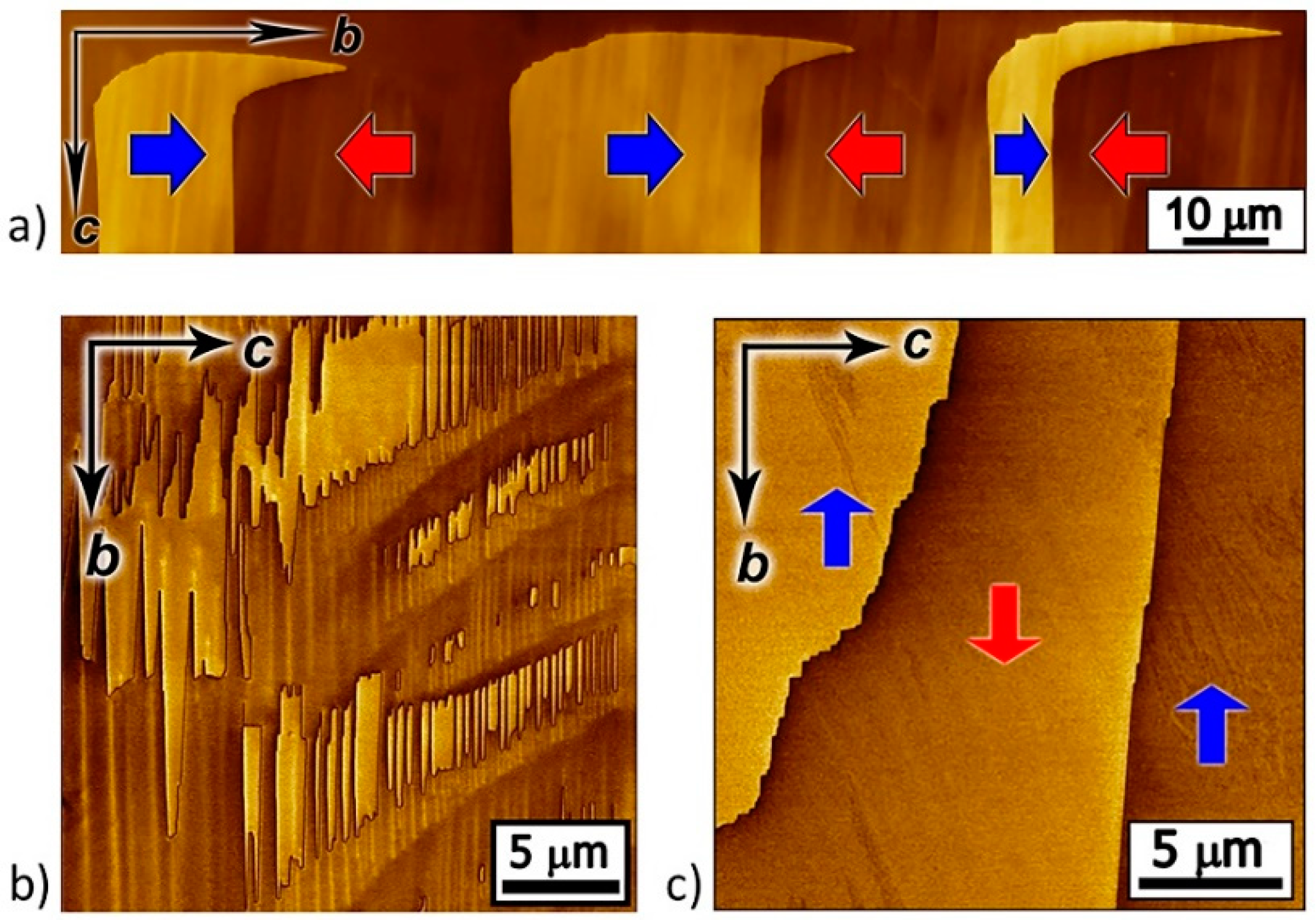

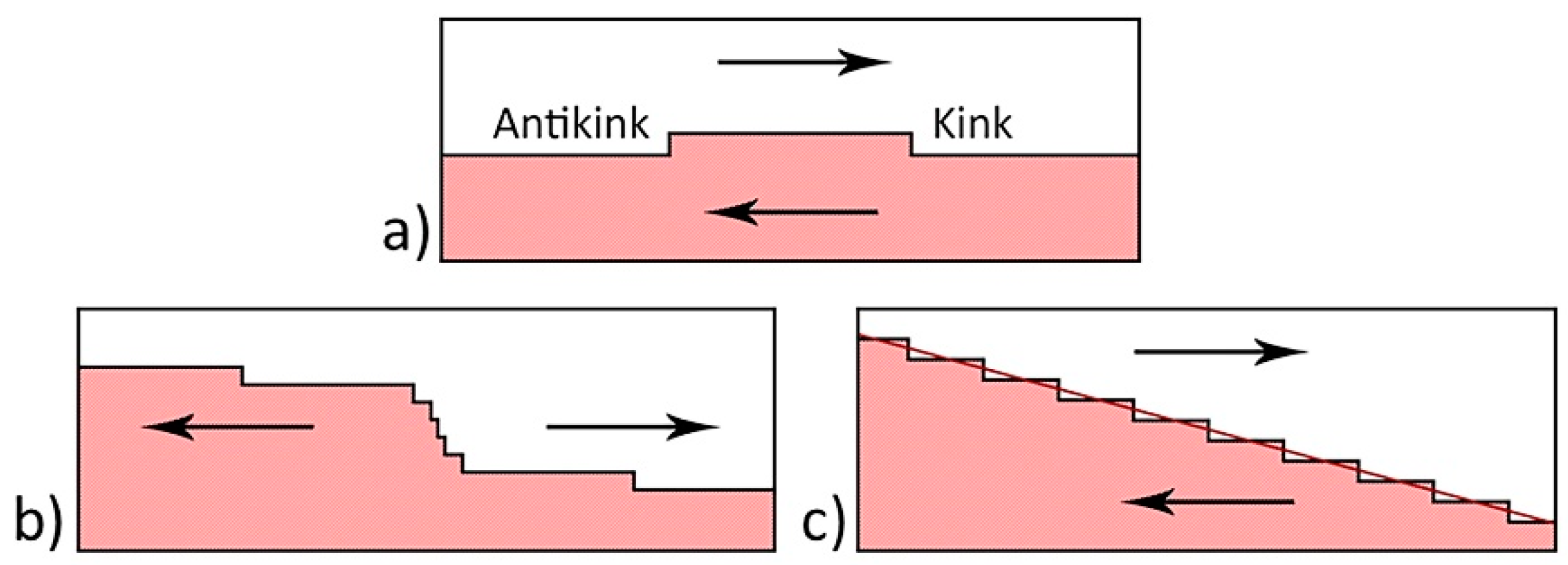
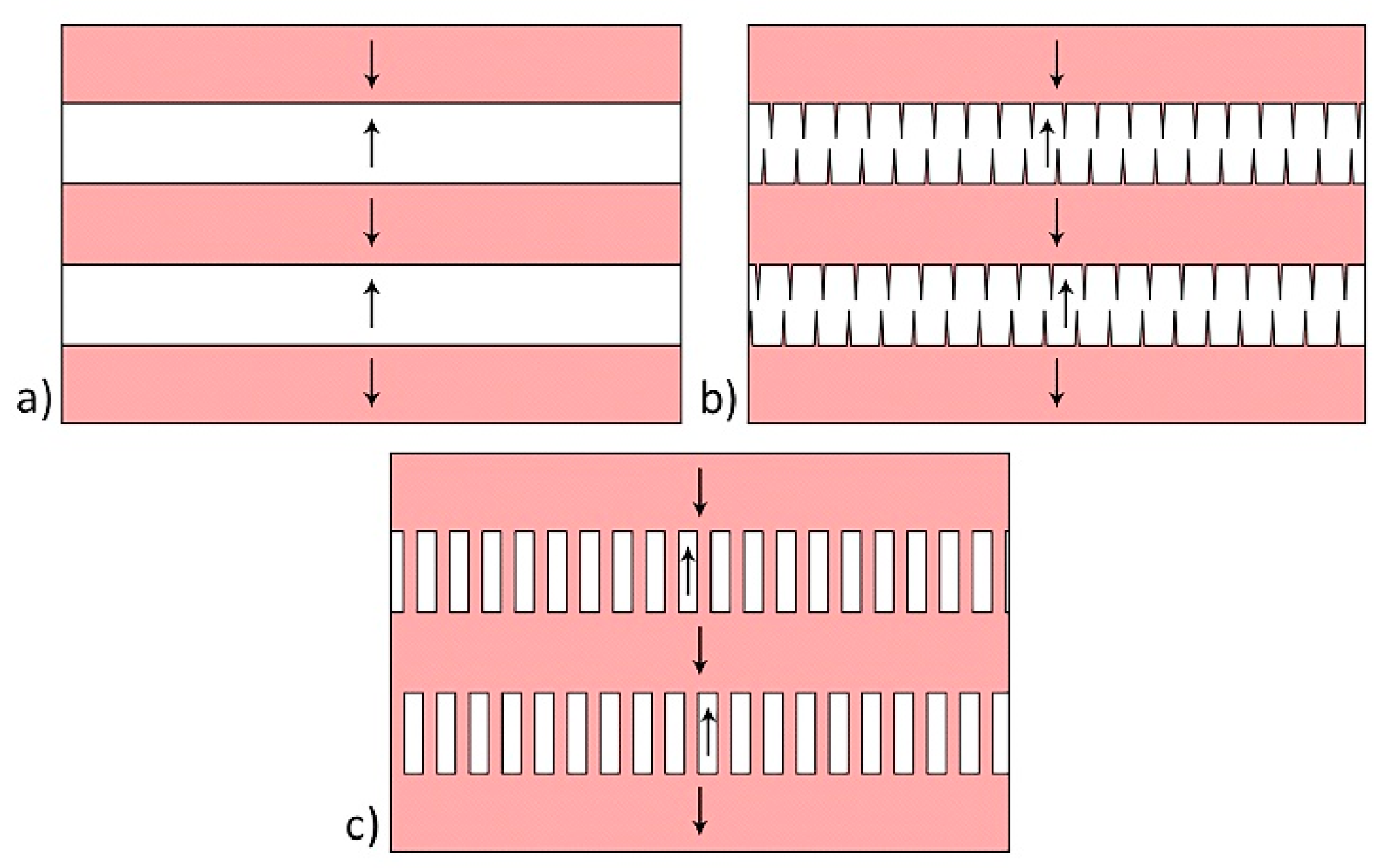
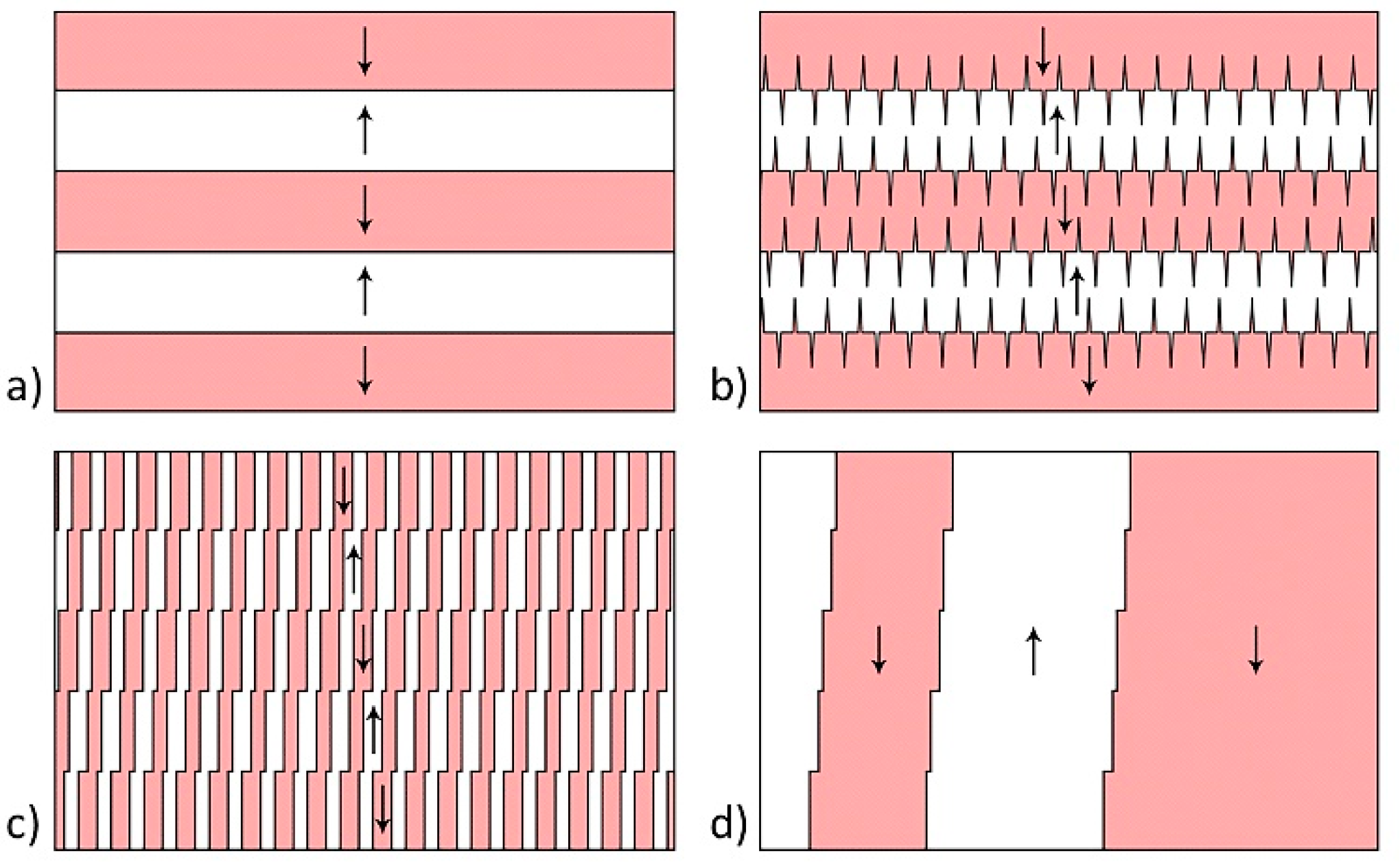
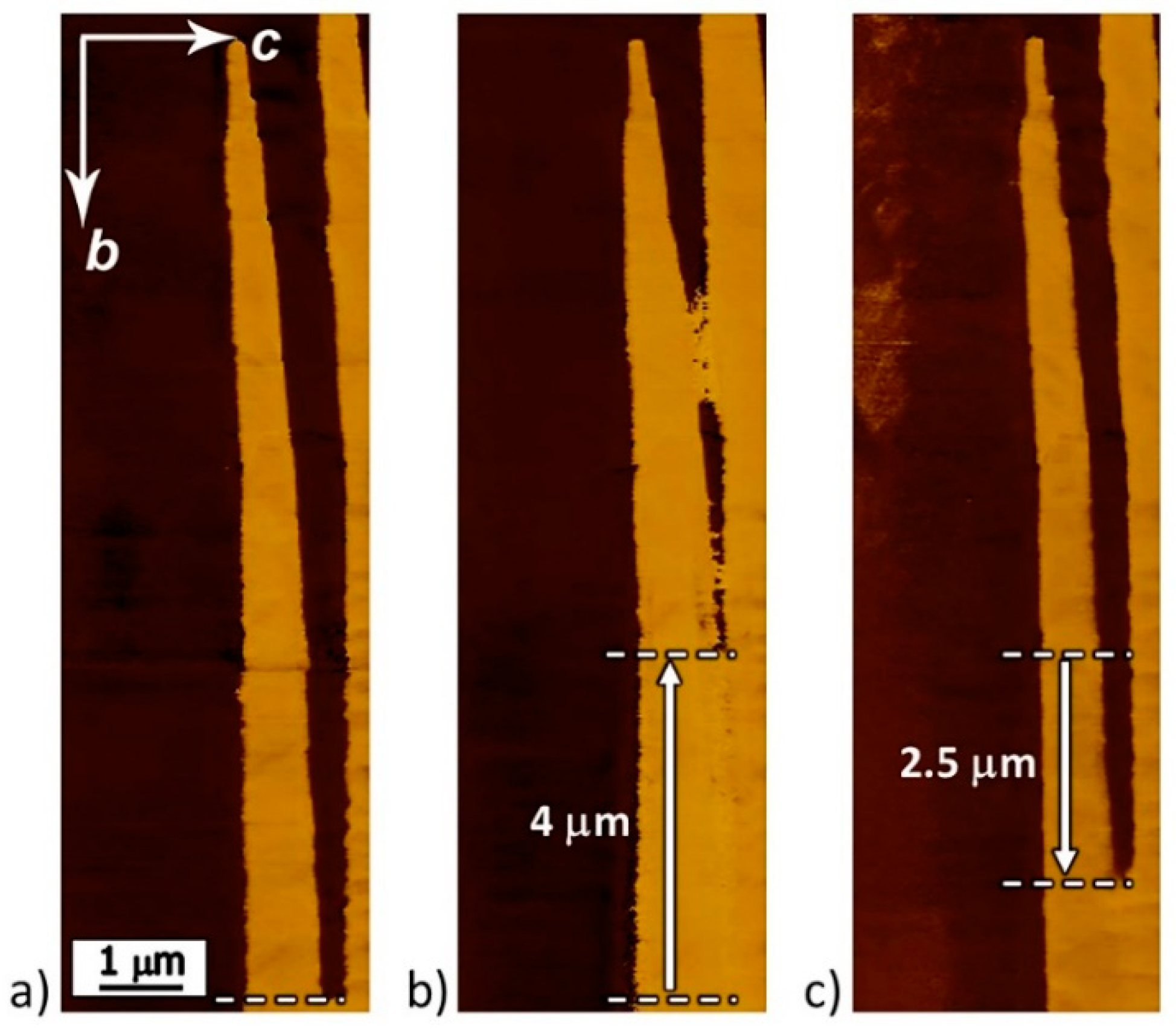


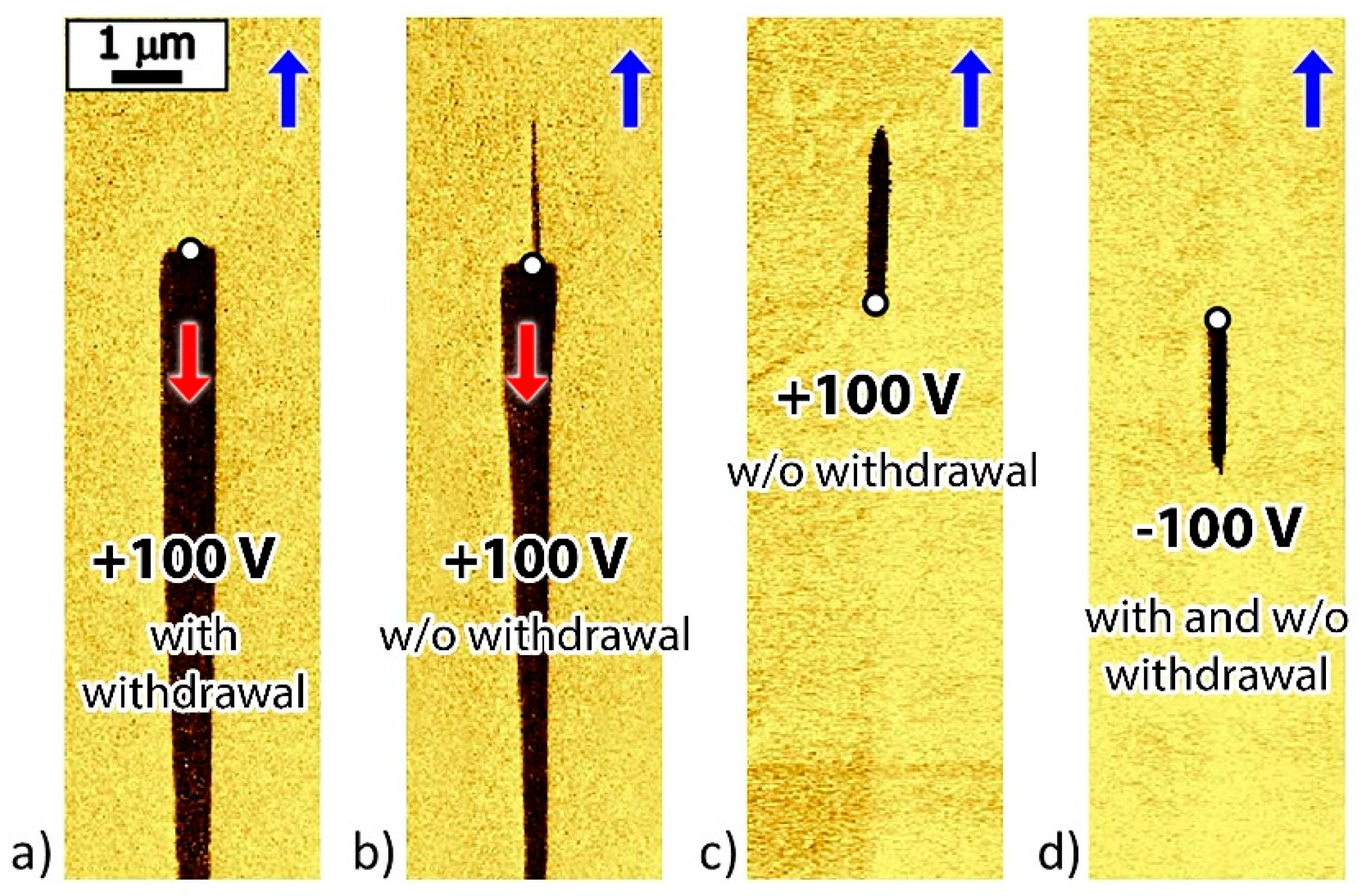
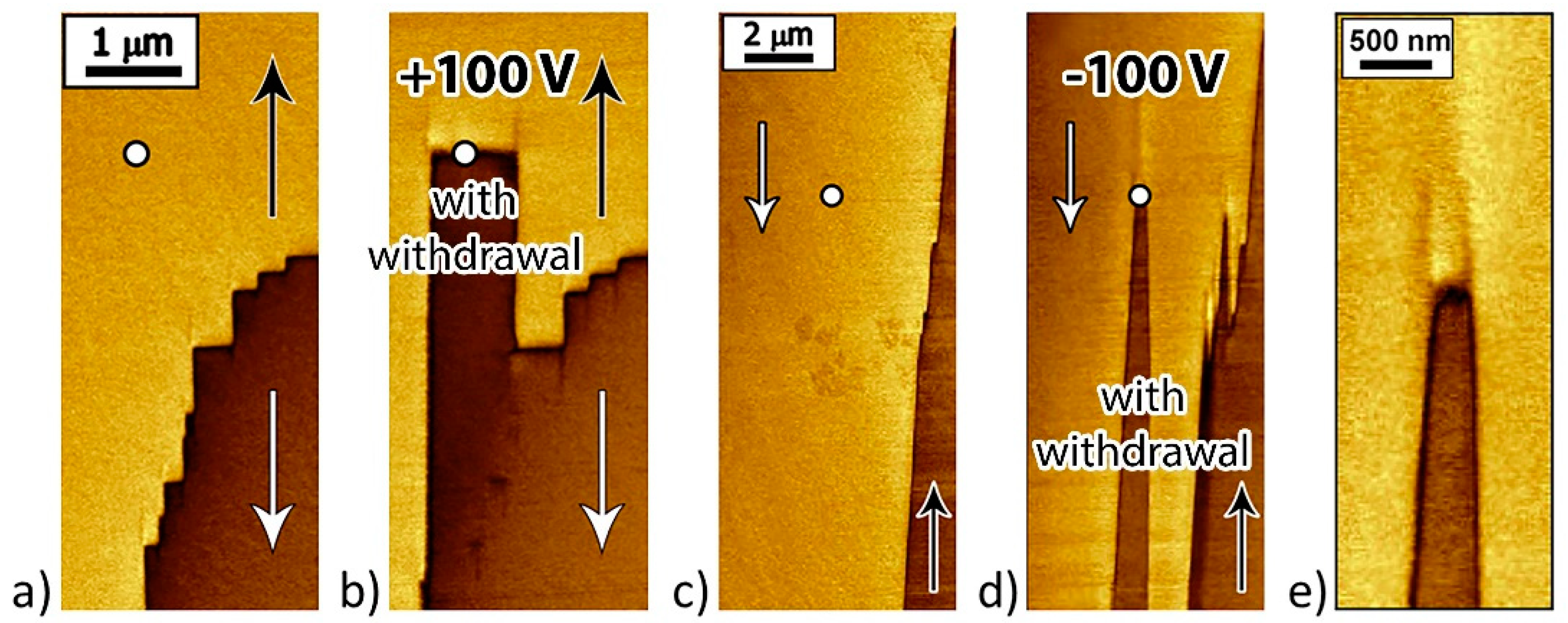
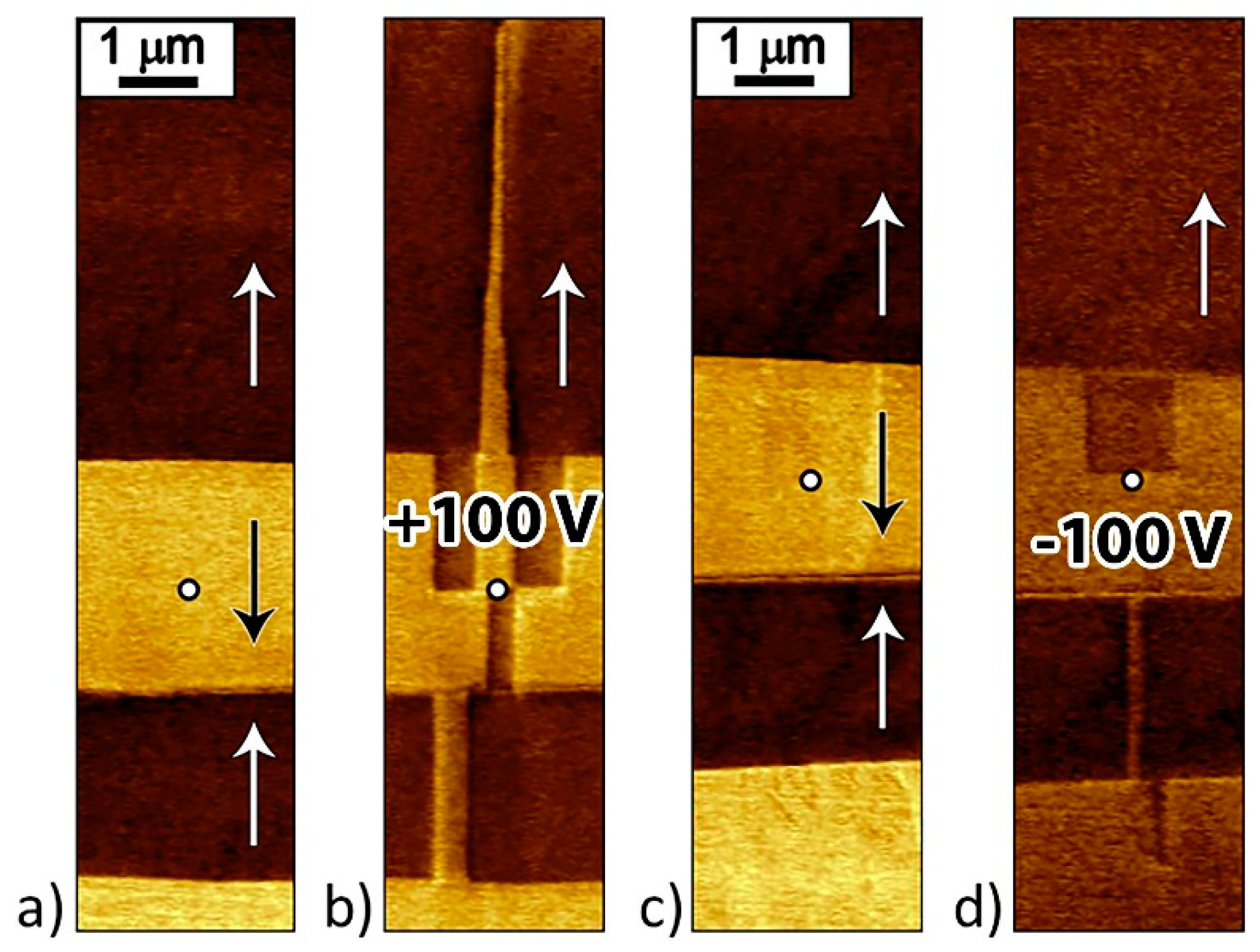

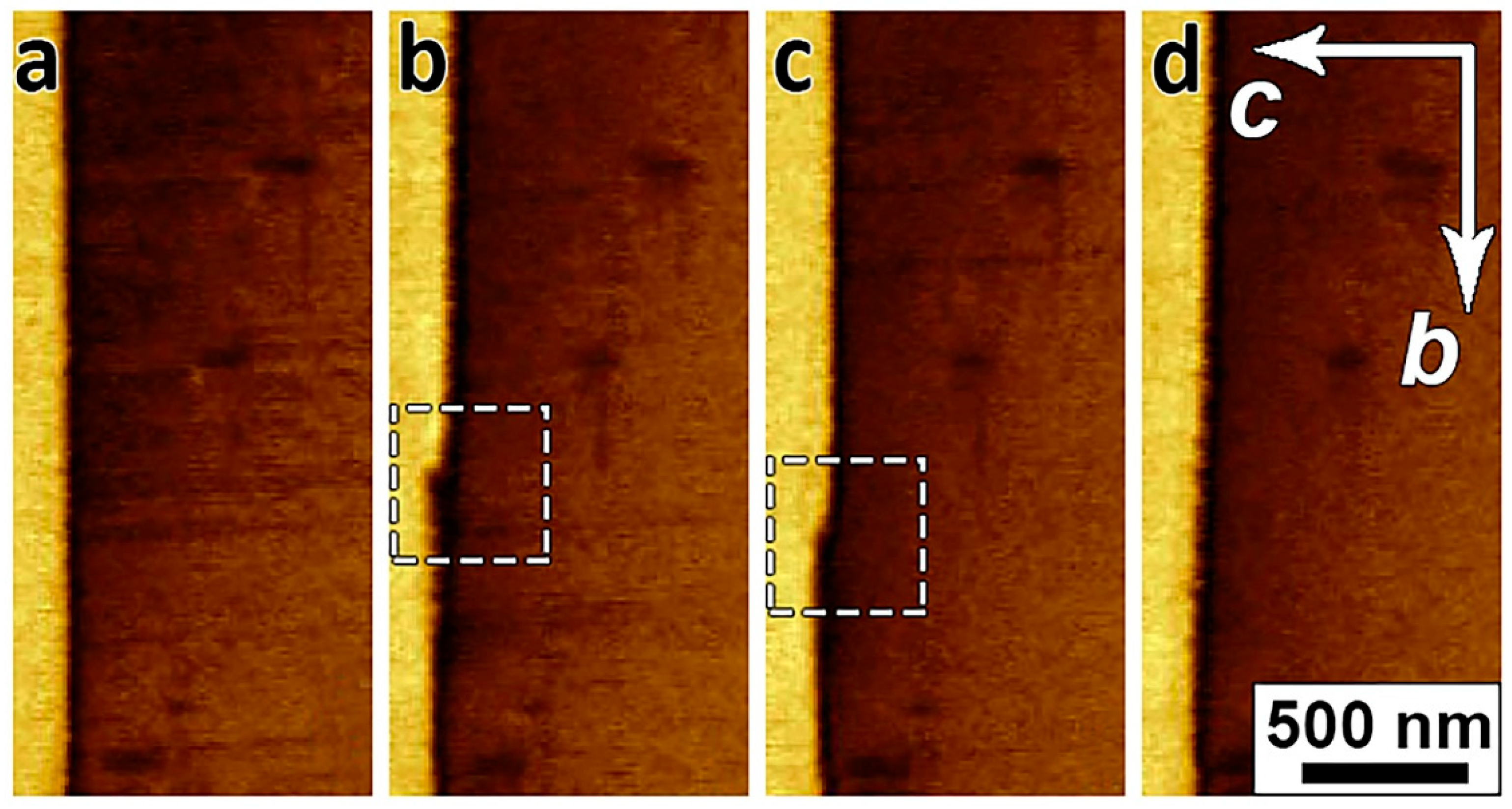
© 2019 by the authors. Licensee MDPI, Basel, Switzerland. This article is an open access article distributed under the terms and conditions of the Creative Commons Attribution (CC BY) license (http://creativecommons.org/licenses/by/4.0/).
Share and Cite
Vasileva, D.; Vasilev, S.; Kholkin, A.L.; Shur, V.Y. Domain Diversity and Polarization Switching in Amino Acid β-Glycine. Materials 2019, 12, 1223. https://doi.org/10.3390/ma12081223
Vasileva D, Vasilev S, Kholkin AL, Shur VY. Domain Diversity and Polarization Switching in Amino Acid β-Glycine. Materials. 2019; 12(8):1223. https://doi.org/10.3390/ma12081223
Chicago/Turabian StyleVasileva, Daria, Semen Vasilev, Andrei L. Kholkin, and Vladimir Ya. Shur. 2019. "Domain Diversity and Polarization Switching in Amino Acid β-Glycine" Materials 12, no. 8: 1223. https://doi.org/10.3390/ma12081223





